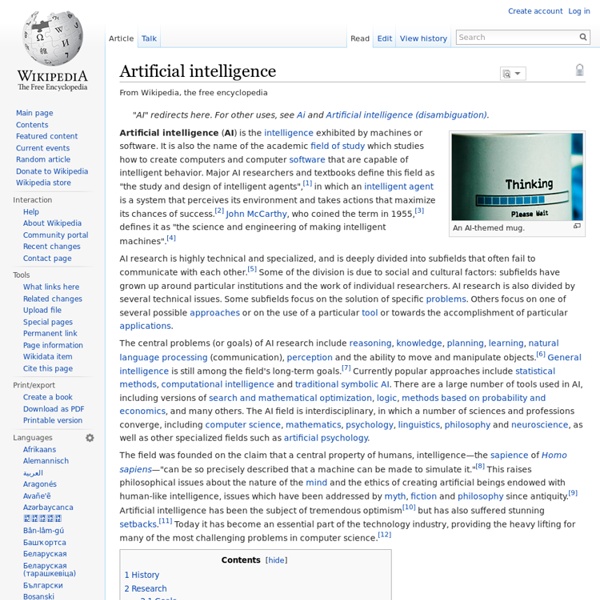Outline of artificial intelligence
The following outline is provided as an overview of and topical guide to artificial intelligence: Artificial intelligence (AI) – branch of computer science that deals with intelligent behavior, learning, and adaptation in machines. Research in AI is concerned with producing machines to automate tasks requiring intelligent behavior. Branches of artificial intelligence[edit] Some applications of artificial intelligence[edit] Philosophy of artificial intelligence[edit]
brain bomb
People maligning a modern diet tend to poke fingers at the the last 30 - 40 years. During this time obesity became a majority issue in the United States, and diabetes and metabolic syndrome afflicted many millions. However, from a nutritional perspective, diets 100 years ago weren’t that terrific either. Obesity was uncommon, but among certain populations, major vitamin and mineral deficiencies were rampant and deadly. Today, it's rare to see scurvy or other famously maritime deficiency diseases aside from serious long-term alcoholics or eating disordered individuals.
AI Gaydar and Other Stories of the Death of Ignorance
After the fall of the Berlin Wall, East German citizens were offered the chance to read the files kept on them by the Stasi, the much-feared Communist-era secret police service. To date, it is estimated that only 10 percent have taken the opportunity. In 2007, James Watson, the co-discoverer of the structure of DNA, asked that he not be given any information about his APOE gene, one allele of which is a known risk factor for Alzheimer’s disease. Most people tell pollsters that, given the choice, they would prefer not to know the date of their own death—or even the future dates of happy events. Each of these is an example of willful ignorance.
Applications of artificial intelligence
Artificial intelligence has been used in a wide range of fields including medical diagnosis, stock trading, robot control, law, remote sensing, scientific discovery and toys. However, many AI applications are not perceived as AI: "A lot of cutting edge AI has filtered into general applications, often without being called AI because once something becomes useful enough and common enough it's not labeled AI anymore," Nick Bostrom reports.[1] "Many thousands of AI applications are deeply embedded in the infrastructure of every industry." In the late 90s and early 21st century, AI technology became widely used as elements of larger systems, but the field is rarely credited for these successes. Computer science[edit] AI researchers have created many tools to solve the most difficult problems in computer science.
singular hubbing
Udacity gives students videos that they can watch at their own pace and be continually quizzed on. This past August fellow Singularity Hub writer Aaron Saenz wrote about Udacity, the online university created by Stanford artificial intelligence professor and Google autonomous vehicle leader, Sebastian Thrun. At the time Thrun was gearing up to teach his Introduction to Artificial Intelligence course to a class of 200 at Stanford. But why teach 200 when you can teach 1,000…or 160,000? With Udacity, Thrun and fellow AI giant Peter Norvig created an online version of the course, and anyone that wanted to enroll could – for free.
Banking and financial services: New technology solves GDPR
Data privacy is driving the European Union’s General Data Protection Regulations (GDPR) in the UK, and yet it’s widely felt that banks and other financial services institutions have run out of time to find ways to comply with the requirements. Looming on the horizon for failing to comply is a dark cloud of significant financial penalties. Banking and financial services: New technology solves GDPR Ashton Young, writing for Data Centre News on 26th July 2017 in his article ‘Majority of Organisations Think They’re GPDR Compliant Actually Aren’t’, says a global study by Veritas says the fines that could be imposed for non-compliance could be up 4 percent of global annual turnover or 20 million euros – whatever is the greater – writes Graham Jarvis, Business and Technology Journalist.
Category:Artificial intelligence
From Wikipedia, the free encyclopedia Subcategories This category has the following 32 subcategories, out of 32 total. Pages in category "Artificial intelligence"
construct filters
Previous article in the series: A Quick Overview of MSAA Despite having the flexibility to implement a custom resolve for MSAA, the “standard” box filter resolve is still commonly used in games. While the box filter works well enough, it has some characteristics that can be considered undesirable for a reconstruction filter. In particular, the box function has a discontinuity at its edge that results in an infinite frequency response (the frequency domain equivalent of a box function is the sinc function).
ENISA report: Concepts and recommendations on European Data Protection Certification mechanisms
Today, ENISA publishes a report destined to familiarise data protection experts with the terminology of certification and to clarify concepts which are relevant to the General Data Protection Regulation (GDPR) certification. The report identifies and analyses challenges and opportunities faced by data protection certification mechanisms, including seals and marks. As of 25 May 2018, GDPR will be the main data protection legal framework in the EU and will be directly applicable to all EU Member States.
FLI - Future of Life Institute
(If you have questions about this letter, please contact tegmark@mit.edu) Artificial intelligence (AI) research has explored a variety of problems and approaches since its inception, but for the last 20 years or so has been focused on the problems surrounding the construction of intelligent agents - systems that perceive and act in some environment. In this context, "intelligence" is related to statistical and economic notions of rationality - colloquially, the ability to make good decisions, plans, or inferences. The adoption of probabilistic and decision-theoretic representations and statistical learning methods has led to a large degree of integration and cross-fertilization among AI, machine learning, statistics, control theory, neuroscience, and other fields.



